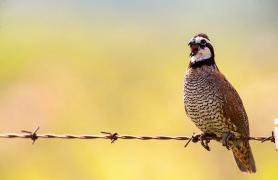Explore a marsh to see wildlife coming and going. (But don’t forget to bundle up!)
Did You Know?
The cat’s tail or “brown sausage” part of a cattail can contain more than 200,000 tiny, fluffy seeds.
Take a Closer Look
Since wetland soils stay soggy, plants need a way to get oxygen down to their roots. Cattails have pipes in their leaves and stems that transport oxygen downward. Cut a cattail leaf in cross section, and you’ll see the tiny tubes.
Look
Most wetland mammals come out at night, so you may not see many in the flesh and fur. But footprints in the snow show where they’ve been. Look for these animal autographs the next time you visit a marsh.
- Beaver
- Mink
- Muskrat
- Otter
- Raccoon
Heads Up!
Never walk out on ice without an adult’s permission. Wetlands aren’t always shallow, and ice isn’t always thick enough to support your weight.
Look
Nearly two dozen kinds of ducks migrate through Missouri from fall through spring. Here are a few common ones to look for.
- Mallard
- Northern shoveler
- Northern pintail
- Gadwall
- American wigeon
- Green-winged teal
Smell
Marsh bottoms pass gas. A handful of marsh muck contains billions of bacteria and other microscopic creatures. Some of them break down dead plants and animals. As they do, they release gases that smell like rotten eggs. Pee-yoo!
Look
When it comes to what they eat, bald eagles aren’t picky. Fish makes up most of their menu, but they won’t turn up their beaks at geese or any other meat they find — even if it has been dead for a while.
What Happened Here?
This messy pile of plants and mud is a muskrat house. A muskrat heaps up vegetation until it has made a small mound that sticks up out of the water. Then the furry builder digs an underwater entrance and a cozy living chamber inside.
What Happened Here? Bottoms up!
This duck is dabbling, which is a fancy way of saying it’s dipping its head underwater to grab a bite to eat. The duck will suck water into its beak, let it dribble out the sides, and strain out seeds and insects. Yum!
Also In This Issue


And More...
This Issue's Staff
Les Fortenberry
Karen Hudson
Angie Daly Morfeld
Noppadol Paothong
Marci Porter
Mark Raithel
Laura Scheuler
Matt Seek
David Stonner
Nichole LeClair Terrill
Stephanie Thurber
Cliff White






















